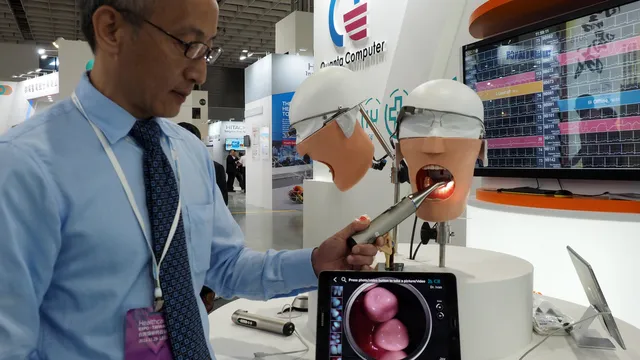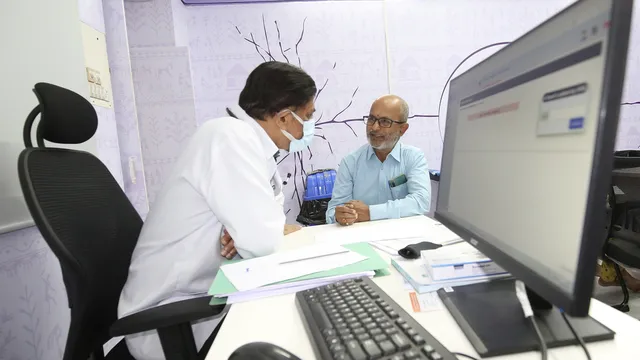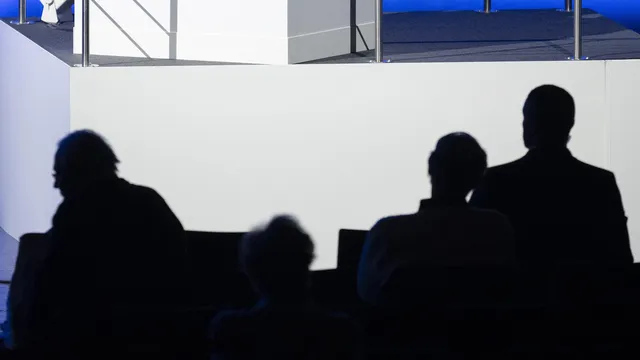Many of us will lose at least one permanent tooth during our lifetime, whether due to disease or accident—for example, a punch in the face or a failed skateboard trick. If this happens to you, you will join nearly 178 million adults in the US who have lost at least one tooth. And the options for replacement haven't changed much in millennia: artificial replacements.
Dental technology has advanced since the ancient Etruscans made artificial teeth from ox bones, but not by much. The metal implants we use today deteriorate over time, causing significant pain. But what if there was another way? What if, instead of implants and dentures, you could restore lost teeth?
That's the question a journalist asked Paul Sharpe about 20 years ago, completely changing the shape and direction of his research. Sharp, a craniofacial surgeon at King's College London, and his colleagues had been studying for years how a handful of cells turn into a mouth full of teeth. At that time, the field of tissue engineering was quite well developed, if not in clinical practice, then at least in scientific research. Restoring teeth would be a natural extension. So Sharp began to think, "If we want to restore a tooth, what do we need to do?"
It turns out that there are several ways to successfully restore a lost tooth. Sharp and his team spent about two decades uncovering one mechanism, while researchers at Tufts University in Massachusetts took a different approach. Both approaches have yielded positive results in laboratory conditions. And scientists in Japan are currently conducting clinical trials of a drug that promises to restore teeth in the human mouth almost from scratch.
This could be the future of dentistry: instead of lifeless metal implants, we could have new living teeth that function and feel just like the old ones. Technically, this is entirely possible. So why hasn't it happened yet?
According to the World Health Organization, nearly 7% of people over the age of 20 worldwide have lost all their teeth, and among people over the age of 60, that percentage jumps to 23%. In the UK, 5% of people aged 16 or older have no natural teeth. Of course, there are dramatic ways to lose teeth, but most often it is due to tooth decay—cavities that occur when bacteria living on the teeth produce acids that dissolve the hard parts. And for now, if you lose a tooth as an adult, you cannot restore it naturally.
"The most common treatment today is to place a titanium implant," said orthodontist Pamela Yelik of Tufts University. In the 1950s, physiologist Per-Ingvar Brånemark placed a titanium chamber in a rabbit's leg to observe blood circulation, but a few months later he found that he could not remove it because the bone tissue had fused with it. Branemark accidentally discovered that titanium can bond with bone. This makes it ideal for tooth replacement.
Titanium implants are standard today, but they have their drawbacks. Since they are made of metal, they do not cause any sensation. "You can't feel them when you chew with them," said Yelik.
Unlike implants, natural teeth have ligaments that connect them to the bone to absorb some of the force of chewing, reducing stress on the jaw. "When you have an implant, you have nothing to soften the forces of chewing," Yelik said. Constant chewing can lead to bone destruction around the implant, resulting in inflammation and pain.
A living tooth, however, would last longer and be healthier. It would feel like a real tooth, with nerve endings, and would be less susceptible to infection or rejection. "The ultimate goal," Sharp noted, "is to replace the lost tooth with a biological tooth that is completely normal."
But to understand how a replacement tooth is made, you first need to understand how we get teeth in the first place. To form a tooth, two types of cells must interact: dental epithelial cells form the hard enamel that covers our teeth, while dental mesenchymal cells give rise to other parts of the tooth, including the dentin, which is located under the enamel, and the soft pulp in the center of the tooth.
The good news is that it is possible to obtain dental mesenchymal cells from the pulp of an adult tooth, such as an extracted wisdom tooth. The bad news is that dental epithelial cells are only found in young children. "These cells practically disappear after adult teeth grow in," Yelik explained.
There is another problem: even if you manage to obtain dental epithelial cells from somewhere, they need the right conditions to turn into something resembling a tooth.
Inspired by tissue engineering, Yelik and her colleagues are trying to solve this problem by creating a scaffold—in this case, a bundle of fluffy fibers similar to a cotton swab—on which the cells can attach and turn into tissue.
It worked: they obtained the two types of cells from pig molars and placed them on scaffolds made of polyester, then implanted these small structures into the mouths of rats. After 20 to 30 weeks, they had teeth—or rather, "recognizable tooth structures"—containing both dentin and enamel. "They formed these tiny, miniature, beautiful tooth crowns," Yelik said.
This happened back in 2002. Since then, she and her colleagues have been continuously refining the process. In their latest paper, published in 2024, Yelik and Wei Bo Zhang, also from Tufts University, used an improved scaffold: tooth buds from pigs, completely cleared of cells. They then seeded them with a mix of tooth cells—some from humans, some from pigs—and implanted the resulting bioengineered structures into the mouths of pigs. After two to four months, the structures developed into "tooth-like tissues," a model that, according to Yelik, "we could ultimately achieve in humans."
However, Sharp is skeptical that teeth grown in this way will ever be able to reproduce the entire complex three-dimensional structure of normal teeth. "You have two types of hard tissue that are created by different cells that are unique in the body. They are found nowhere else but in teeth," he says. Nevertheless, Sharp supports Yelik's work "because I may be wrong."
While Yelik refines his model, others are working on a different approach—trying to trick adult cells into behaving like embryonic stem cells.
All cell types in our bodies started out as embryonic stem cells. The most versatile ones, which can form any type of cell, are called pluripotent stem cells. In the 2000s, biologists led by Shinya Yamanaka, then at Kyoto University, Japan, showed that adult cells could be "reprogrammed" to behave like pluripotent stem cells by adding a few transcription genes, now known as Yamanaka factors.
These "induced pluripotent stem cells" (iPSCs) can be used to create any desired cell type. Since then, researchers have been trying to use iPSCs to grow replacement tissues and organs.
In theory, iPSCs would be ideal for creating new teeth. Many different types of cells from adult teeth have been converted into iPSCs, and as early as 2013, researchers in China demonstrated that iPSCs can form tooth-like structures. A 2024 review claimed that iPSCs could be used to repair damaged enamel.
However, according to Sharp, unless the cost of creating and using iPSCs falls below the cost of a dental implant—which in the UK can be around several thousand pounds—iPSCs will probably never be used to restore teeth. "It doesn't matter how good the science is. If it's too expensive to reach the market, then it's not worth doing at all," he explained.
So Sharp and his colleagues took a different approach: they tried to persuade adult cells to turn into teeth.
When dental epithelial cells and dental mesenchymal cells combine to form a tooth, they do so by sending each other a complex series of chemical signals. For this to work, at least one of the cell types must be an embryonic cell—only they send the right signals to start the process. "That's a big, big hurdle," Sharp said.
To overcome it, Sharp and his team mapped out the sequence of chemical signals that cells send during tooth development.
In 2024, they published an atlas of the cells involved in the different stages of tooth development and found a way to increase the strength of the chemical signals. "The challenge now is to introduce these signals into this combination of cells and get the two adult populations to think that one of them is doing the right thing to start the process and create a tooth," Sharp said.
The appeal of this approach is that it essentially replicates what happens in normal tooth development: "Our bodies know how to create teeth. However, convincing adult cells to do so is difficult," he explained.
The reality is that after more than 20 years of research, none of the methods for restoring teeth have been used in clinical trials on humans, let alone in the dentist's office. This is partly due to the fact that dentistry is relatively underfunded, especially compared to other areas of medicine such as oncology or cardiology. "You can live without teeth, but you can't live without a heart or a brain," Yelik noted.
But perhaps another approach is on the horizon. Mary McDougall of the University of British Columbia in Vancouver began trying to regenerate tooth cells and structures 20 years ago. "I remember all my interviews from back then, and it was always talked about as a 5- to 10-year timeframe," she said sadly. But with the revelation of the complexity of tooth development, it became clear that this was overly optimistic.
Today, however, McDougall is enthusiastic again because there are signs that humans may be able to grow new teeth without the involvement of stem cells.
McDougall is involved in research that is laying the groundwork for a new approach that works by mimicking the biology underlying a rare genetic condition called cleidocranial dysplasia. People with this condition often have no collarbones or they are severely underdeveloped, and many of them have extra teeth. Cleidocranial dysplasia is caused by mutations in a gene called RUNX2, which encodes a protein called Runt-related transcription factor 2, which is involved in bone and tooth development.
In 2016, McDougall co-authored a study led by Katsu Takahashi of Kyoto University in Japan that examined the function of RUNX2. Working with genetically modified mice, the researchers found that RUNX2 works in tandem with another gene called USAG-1 as a master switch that turns tooth development on and off.
This explains why mutations in RUNX2 can cause people with cleidocranial dysplasia to grow extra teeth—and why genetically modified mice in which USAG-1 is deactivated also have extra teeth.
Takahashi and his colleagues go even further, suggesting that it may be possible to induce tooth regeneration by inhibiting USAG-1. In 2021, they studied mice with genetic abnormalities that stop their teeth from growing and found that they could reverse this process by inducing mutations that deactivate USAG-1 or by giving the mice antibodies against the protein encoded by the gene. In a second study, they obtained the same result using RNA targeting the USAG-1 gene.
Takahashi and his colleagues founded the company Toregem Biopharma to investigate whether giving humans antibodies against the protein encoded by USAG-1 could lead to the growth of new teeth.
In 2024, they reported that they had developed such an antibody and had tested it successfully in mice. Soon after, they announced the start of a Phase I clinical trial. They gave the drug to adult men with no significant health problems who were missing at least one tooth to determine the safety and potential dosage of the drug.
If the study is successful, the company plans to test the treatment in children between the ages of 2 and 7 with congenital anodontia, a genetic condition in which teeth do not grow. "A treatment for these people would be a huge benefit," McDougall said. Otherwise, "they will wear dentures for the rest of their lives," she added.
Treating such young children is easier because they still have dental epithelial cells, McDougall said, but it is unclear whether Takahashi's approach would be useful for adults who have lost their teeth and do not have dental epithelial cells.
McDougall speculates that a small number of stem cells may remain in the jaw that could respond to the drug. Sharp and others have doubts. For one thing, it may be difficult to control which teeth start to grow, Sharp noted. If a person is missing only one tooth, it would be unfortunate to induce the development of six.
The answer to this and other questions will come with the results of clinical trials. This will likely take several years, although Toregem Biopharma has announced that it wants to bring the drug to market in 2030.
However, the answer to the journalist's question, which prompted Sharp's research in an exciting new direction, is clear. The technical obstacles to tooth restoration have largely been overcome, but the financial ones remain.
Sharp fears that the technology may never be realized because research funders, pharmaceutical companies, and capitalists are simply not interested. Toregem Biopharma may be a rare exception. | BGNES

 Breaking news
Breaking news
 Europe
Europe
 Bulgaria
Bulgaria







